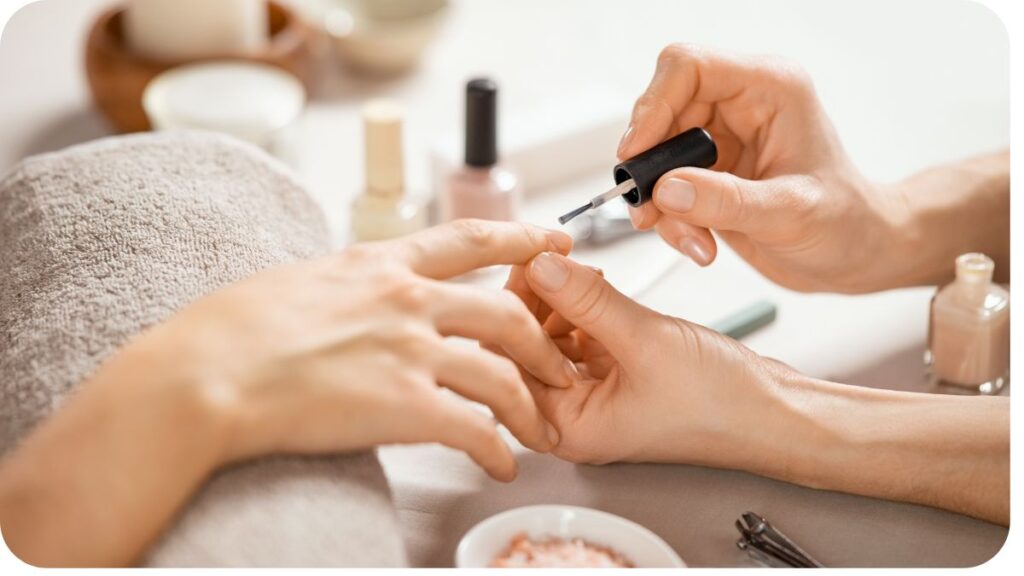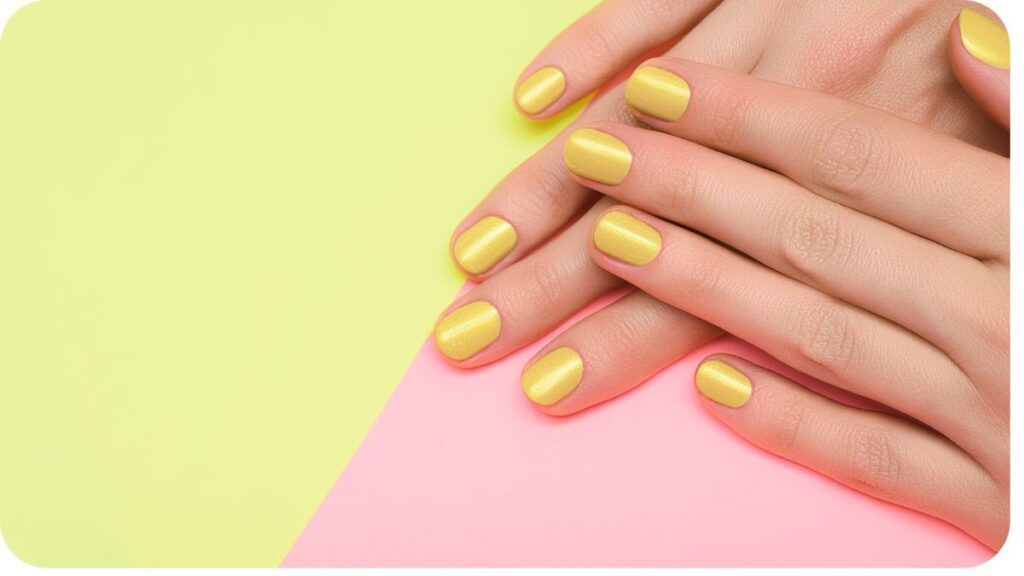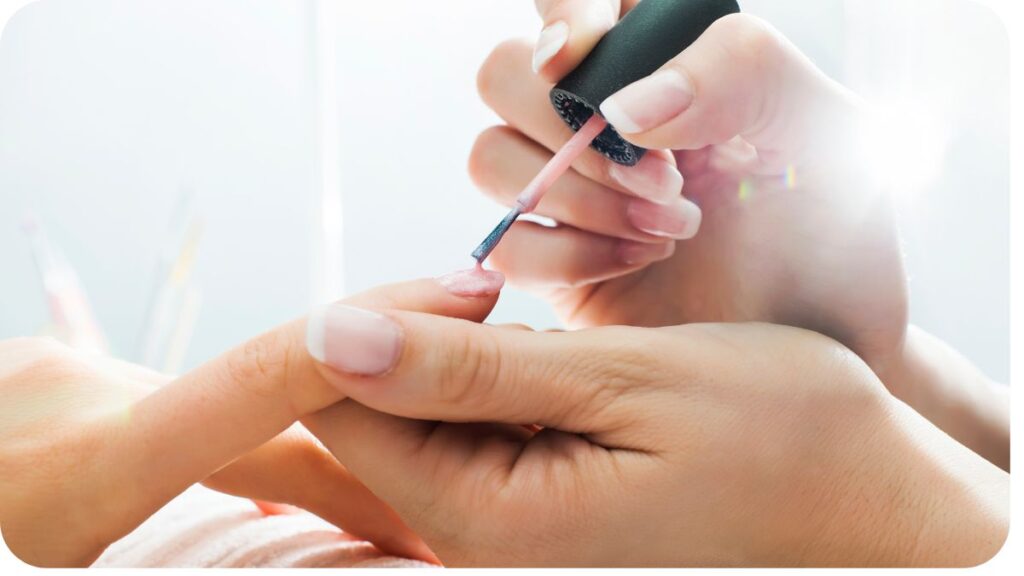Welcome to a comprehensive guide on troubleshooting your nail polish woes! Nail polish can sometimes be a bit tricky to work with, leading to issues like peeling, streaky applications, chipping, and more.
In this article, we’ll dive into common nail polish problems and provide you with expert fixes, drawing from our expertise in the field. Each section will be accompanied by a table summarizing the issue and its corresponding fixes, making it easier for you to understand and address the problem at hand. So, let’s get started!
| Takeaways |
|---|
| Troubleshooting common nail polish issues can help you achieve a flawless manicure. |
| Avoid shaking nail polish bottles as it introduces air bubbles. Instead, roll the bottle gently between your palms before applying. |
| Ensure a dry application environment to prevent bubbling and smudging. |
| Allow each coat of nail polish to dry completely before applying the next one to achieve an even texture. |
| Use a base coat to prevent staining and a top coat for added protection and longevity. |
| Proper storage, such as keeping the polish in a cool, dark place, can extend its lifespan. |
| Nail polish thinner can be used to restore thickened polish to its original consistency. |
| Patience is key – wait for your nails to dry completely before engaging in activities that could smudge or damage the polish. |
| Avoid prolonged wear of dark nail polish to minimize the chances of yellowing or staining. |
| Taking preventive measures, such as using base and top coats, can help prevent common nail polish issues. |
2. Table of Common Nail Polish Issues and Fixes

2.1 Issue 1: Peeling Nail Polish
| Issue | Cause | Fix |
|---|---|---|
| Peeling Nail Polish | Oily nails or improper base coat | Clean nails thoroughly, use a quality base coat |
Are you tired of having your nail polish peel off just after a few days? This issue can be quite frustrating, but the good news is that it has a fix! Peeling nail polish is often caused by applying polish to oily nails or not using a proper base coat.
To overcome this problem, make sure you clean your nails thoroughly before application and use a high-quality base coat that acts as a primer and promotes better adhesion.
Enhance your nail creativity with the latest nail art trends. From minimalist designs to vibrant patterns, this guide ensures your nails stay on-trend and stylish throughout the year.
2.2 Issue 2: Streaky Application
| Issue | Cause | Fix |
|---|---|---|
| Streaky Application | Thick or old nail polish, improper application technique | Thin out old polish using nail polish thinner, practice proper application technique |
Do you ever find streaks appearing on your nails after applying polish? This issue can make your manicure look less than flawless. Streaky application is often caused by using thick or old nail polish or having an improper application technique.
To resolve this, consider thinning out your old polish with a nail polish thinner. Additionally, practice a proper application technique, making sure to apply thin, even coats to achieve a smooth and streak-free finish.
2.3 Issue 3: Chipped Nail Polish
| Issue | Cause | Fix |
|---|---|---|
| Chipped Nail Polish | Insufficient curing time, inadequate top coat, excessive hand use | Allow sufficient drying time, apply a durable top coat, protect hands from excessive use |
Nothing is more disheartening than having your freshly painted nails chip within a day or two. If your nail polish chips easily, it could be due to various reasons. Common causes include not allowing sufficient curing time between coats, using an inadequate top coat, and subjecting your hands to excessive use.
Patience is key here to ensure you give each coat of polish ample time to dry completely. Additionally, apply a reliable top coat that provides durability and protects the polish. Lastly, be mindful of excessive hand use, such as opening cans or typing, to prevent premature chipping.
Achieve salon-worthy nails at home with these professional manicure tips. Learn the secrets to flawless nail care, including shaping, cuticle care, and polish application, for a perfect, long-lasting manicure every time.
2.4 Issue 4: Slow Drying
| Issue | Cause | Fix |
|---|---|---|
| Slow Drying Nail Polish | Thick coats, humid environment | Apply thin coats, use a quick-drying top coat, create a dryer environment |
If you find yourself constantly waiting and waiting for your nail polish to dry, it’s time to address the slow-drying issue. Thick coats of polish take significantly longer to dry, so aim for thin, even layers instead.
You can also expedite drying by using a quick-drying top coat specific for this purpose. Moreover, create a drier environment by avoiding humid areas and using a fan or cool air to accelerate the drying process.
2.5 Issue 5: Bubbling Nail Polish
| Issue | Cause | Fix |
|---|---|---|
| Bubbling Nail Polish | Shaking the polish, applying in a humid environment | Roll the polish instead of shaking, ensure a dry application environment |
Have you ever noticed tiny bubbles forming on your freshly painted nails? This issue is often caused by shaking the nail polish bottle before application, which introduces air bubbles into the product.
To prevent bubbling, roll the nail polish bottle gently between your palms instead of shaking it vigorously. Additionally, make sure to apply the polish in a dry environment to prevent moisture from becoming trapped and causing bubbles during the drying process.
Elevate your nail care routine with these easy DIY tips. From strengthening treatments to simple hacks for maintaining healthy nails, this guide empowers you to keep your nails looking fabulous without a salon visit.
2.6 Issue 6: Smudging Nail Polish
| Issue | Cause | Fix |
|---|---|---|
| Smudging Nail Polish | Touching nails before they’re dry, improper top coat application | Avoid touching nails until fully dry, apply a smudge-free top coat |
Are you tired of ruining your nail polish by accidentally smudging it? The key to preventing smudging is to exercise patience. Allow your nails to dry completely before engaging in any activities that could potentially damage the freshly applied polish.
Additionally, ensure you apply a smudge-free top coat, designed to dry quickly and offer protection against accidental smudges. Following these steps will help you achieve a flawless manicure.
2.7 Issue 7: Uneven Texture
| Issue | Cause | Fix |
|---|---|---|
| Uneven Texture | Applying coats too quickly, using old or expired polish | Allow each coat to dry before applying the next, use fresh polish |
Are you encountering an uneven texture on your nails after applying polish? This issue can be attributed to applying coats too quickly, not allowing enough drying time between each layer.
To achieve a smooth texture, ensure you allow each coat to dry completely before applying the next one. This will prevent any smudging or texture issues. Moreover, using fresh polish that hasn’t expired will contribute to a more even and consistent result.
Master the art of at-home manicures with expert advice on nail shaping, cuticle care, and polish application. This comprehensive guide ensures you can achieve professional-looking results without leaving the comfort of your home.
2.8 Issue 8: Color Transfer
| Issue | Cause | Fix |
|---|---|---|
| Color Transfer | Insufficient drying time, friction against surfaces | Extend drying time, avoid contact with surfaces |
Has your nail polish ever transferred its color onto other objects or surfaces? To avoid color transfer, it’s crucial to provide sufficient drying time for your manicure. Even if the surface feels dry to the touch, it’s best to extend the drying time to ensure the polish is completely set.
Additionally, be mindful of friction against surfaces that could cause the color to transfer. Take extra care when handling objects that might rub against your nails and potentially damage your manicure.
2.9 Issue 9: Yellowed Nails

| Issue | Cause | Fix |
|---|---|---|
| Yellowed Nails | Excessive use of dark or pigmented polishes, inadequate base coat | Use a base coat to form a barrier, limit exposure to dark polishes |
Are your nails turning yellow after wearing dark or pigmented nail polish? This discoloration can be quite bothersome, but there are ways to prevent it. Start by applying a base coat before applying your chosen polish.
The base coat acts as a barrier, preventing direct contact between your nails and the pigments in the polish. Additionally, limit your exposure to dark or highly pigmented polishes to minimize the chances of yellowing over time.
Unleash your creativity with these trendy nail art ideas. From bold designs to subtle accents, this collection provides inspiration for every nail enthusiast, helping you express your style and stay on-trend with captivating nail art.
2.10 Issue 10: Stained Nails
| Issue | Cause | Fix |
|---|---|---|
| Stained Nails | Inadequate base coat, prolonged wear of dark polishes | Always use a base coat, limit the duration of dark polish wear |
Do you find that your nails become stained after wearing dark nail polish for an extended period? Stained nails are often a result of inadequate base coat application and long wear of dark polishes.
To prevent staining, make sure to always use a base coat before applying any colored polish. The base coat acts as a protective barrier and minimizes direct contact between your nails and the pigments. Furthermore, limit the duration of time you keep dark polishes on your nails to reduce the likelihood of staining.
2.11 Issue 11: Clumpy Nail Polish
| Issue | Cause | Fix |
|---|---|---|
| Clumpy Nail Polish | Thickened polish, improper storage | Use nail polish thinner, store polish upside down |
Have you ever opened a bottle of nail polish only to find it clumpy and difficult to apply? Clumpy polish is often caused by the product thickening over time or improper storage. If your polish has become thick, consider using a nail polish thinner to restore its original consistency.
Simply add a few drops of the thinner to the bottle and gently shake it to mix the product. Additionally, to prevent future clumping, store your nail polish bottles upside down. This allows the polish to flow toward the brush, minimizing the chances of it thickening.
2.12 Issue 12: Thick or Thin Consistency
| Issue | Cause | Fix |
|---|---|---|
| Thick or Thin Consistency | Aging polish, improper storage | Use nail polish thinner, store polish in a cool, dark place |
Consistency matters when it comes to nail polish application. If you find your polish is either too thick or too thin, it’s time to address the issue. Aging polish can become thicker or thinner over time, affecting its performance.
To fix a thick polish, add a few drops of nail polish thinner and shake well. If your polish is too thin, you can opt to add a drop or two of clear nail polish to thicken it up. Additionally, store your nail polish in a cool, dark place to maintain its proper consistency for longer periods.
2.13 Issue 13: Quick Tip: Preventing Nail Polish Issues
| Issue | Cause | Fix |
|---|---|---|
| Quick Tip: Preventing Nail Polish Issues | Skipping base and top coats, rushing through application | Always use base and top coats, take your time during application |
Prevention is key when it comes to avoiding nail polish issues. By incorporating a few essential steps into your routine, you can minimize the chances of encountering problems. First and foremost, always use a base coat before applying colored polish.
The base coat provides a smooth surface, enhances adhesion, and protects your nails from staining. Additionally, finish off your manicure with a top coat to seal in the color and increase longevity. Lastly, take your time during application, ensuring each layer is applied carefully and with proper drying time between coats.
2.14 Issue 14: Quick Tip: Extending the Lifespan of Nail Polish

| Issue | Cause | Fix |
|---|---|---|
| Quick Tip: Extending the Lifespan of Nail Polish | Improper storage, lack of maintenance | Store polish in a cool, dark place, reseal bottles tightly |
To make your favorite nail polishes last longer, consider these quick tips. Proper storage is crucial to maintaining the integrity of your polish. Store your bottles in a cool, dark place, away from direct sunlight and extreme temperatures.
This will help prevent premature thickening or discoloration. Additionally, ensure you tightly reseal each bottle after use to minimize air exposure and maintain the polish’s consistency. With these simple habits, you can extend the lifespan of your nail polishes and continue enjoying them for many manicures to come.
3. Conclusion
In this comprehensive guide, we’ve covered common nail polish issues and their corresponding fixes. From peeling nail polish to streaky applications, chipping, slow drying, bubbling, smudging, uneven texture, color transfer, yellowed nails, stained nails, clumpy polish, and issues with consistency, we’ve addressed each problem in detail.
Additionally, we provided quick tips on preventing nail polish issues and extending the lifespan of your favorite polishes.
Remember, achieving a flawless manicure takes practice and patience. By implementing the recommended fixes and following preventative measures, you can overcome these common nail polish problems and enjoy beautiful, long-lasting nails. Enjoy your next manicure and happy troubleshooting!
Further Reading
Here are some additional resources where you can find more information on troubleshooting nail polish problems:
- Women’s Health: Nail Problems: This article from Women’s Health covers common nail problems and offers solutions to address them. It provides insights into issues such as nail peeling, chipping, discoloration, and more.
- StyleCaster: How to Fix Every Nail Problem: StyleCaster offers a comprehensive guide to fixing various nail problems. It covers topics like streaky application, chipping, smudging, and offers tips and tricks to overcome these issues.
- Professional Beauty: Your Ultimate Gel Polish Troubleshooting Guide: This troubleshooting guide specifically focuses on gel polish issues. It provides insights into common problems encountered with gel polish applications and offers solutions to help you achieve better results.
FAQs
How long should I wait between applying nail polish coats?
It is recommended to wait at least 2-3 minutes between applying each coat of nail polish. This allows each layer to dry partially and prevents smudging or streaking.
How can I make my nail polish dry faster?
To expedite the drying process of your nail polish, you can apply a quick-drying top coat. This helps speed up the drying time and provides a protective layer to prevent smudging. You can also use a fan or cool air to accelerate drying.
Can I thin out thickened nail polish?
Yes, you can thin out thickened nail polish by using a nail polish thinner. Add a few drops of the thinner to the bottle, and then gently shake it to mix the product. This will restore the polish to its original consistency.
How can I prevent my nails from staining when using dark polish?
To prevent staining, always apply a base coat before applying any colored polish. The base coat acts as a barrier, protecting your nails from direct contact with the pigments in the polish. This helps minimize the chances of staining.
How can I extend the lifespan of my nail polish?
To extend the lifespan of your nail polish, store the bottles in a cool, dark place away from direct sunlight and extreme temperatures. Ensure you tightly reseal each bottle after use to minimize air exposure, which can cause the polish to thicken or deteriorate prematurely.

Hi, you! I’m Hellen James. I’m a beauty and fashion writer who loves to make the world a little more stylish and I’d love for you to join me in the fun! I’ve been writing about beauty and fashion since I was a kid, but it wasn’t until recently that I really knew what it meant to be a real expert.

